Abstract
The identification of antigenic peptides presented on the tumor cell surface by HLA class I molecules and recognized by tumor-specific cytotoxic T lymphocytes may lead to a peptide vaccine capable of inducing protective cellular immunity. We demonstrate that both HLA-A2-restricted breast and ovarian tumor-specific cytotoxic T lymphocytes recognize shared antigenic peptides. At least one of these peptides is derived from the oncogene product of HER2/neu, which is overexpressed in 30-40% of all breast and ovarian cancers. T cells sensitized against this nine-amino acid sequence demonstrate significant recognition of HLA-A2+, HER2/neu+ tumors. Since 50% of the tumor-cell population is HLA-A2+ and many different tumors express HER2/neu, this peptide may be widely recognized and have many clinical applications.
Full text
PDF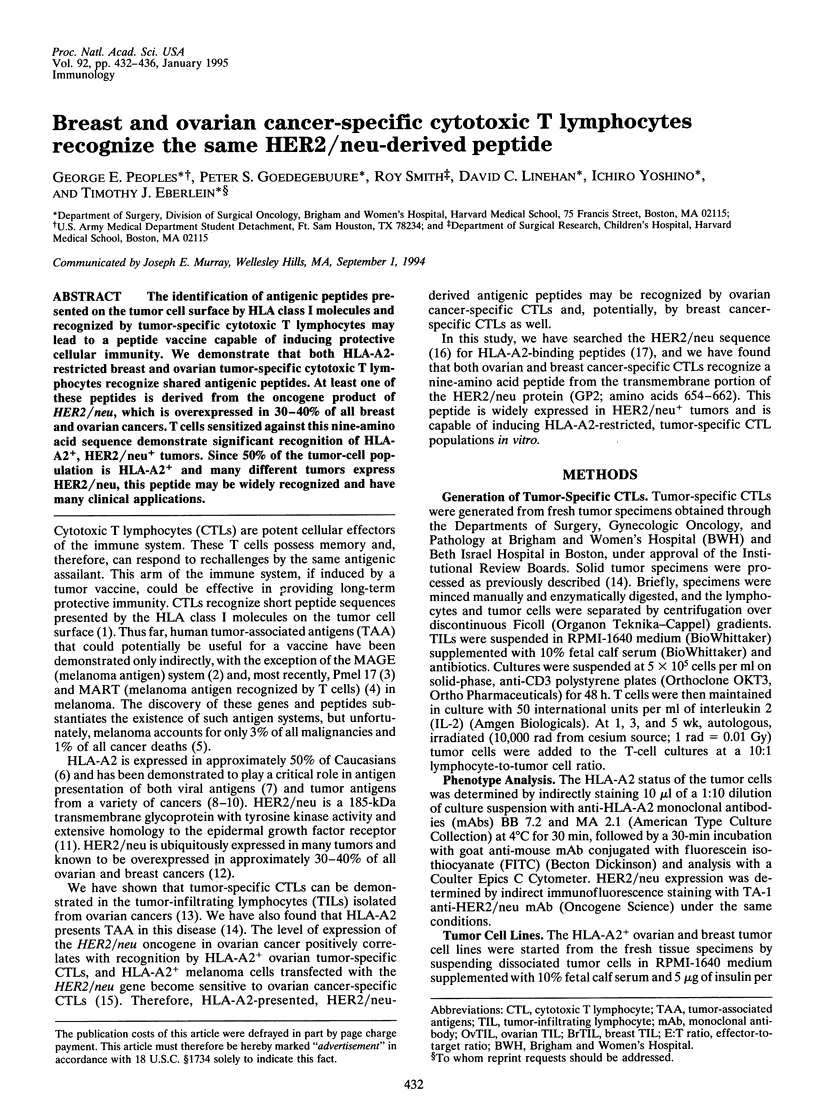
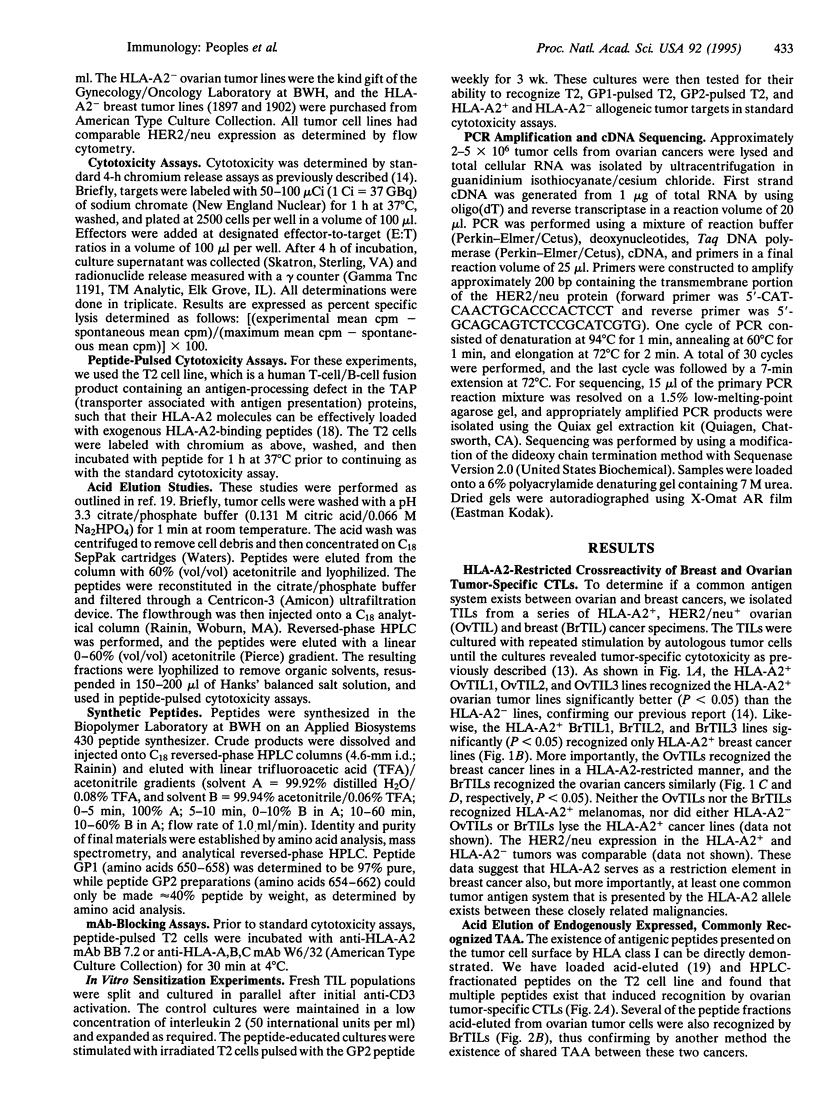
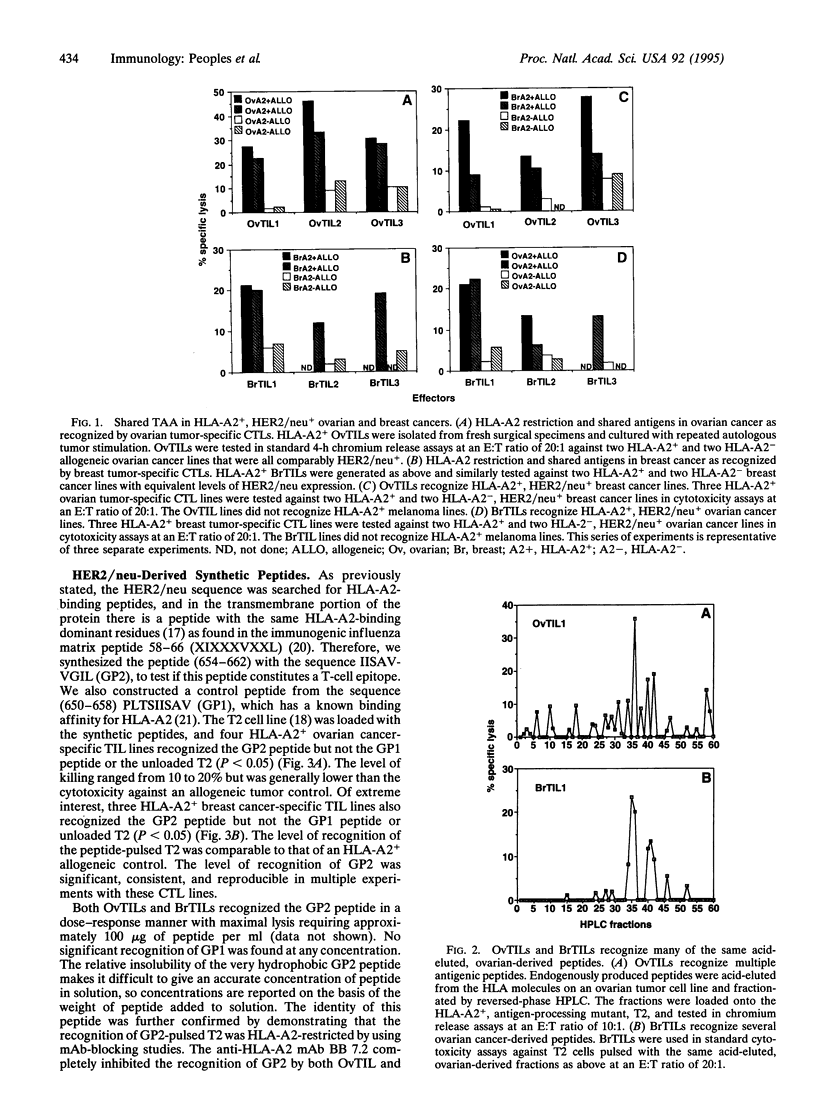
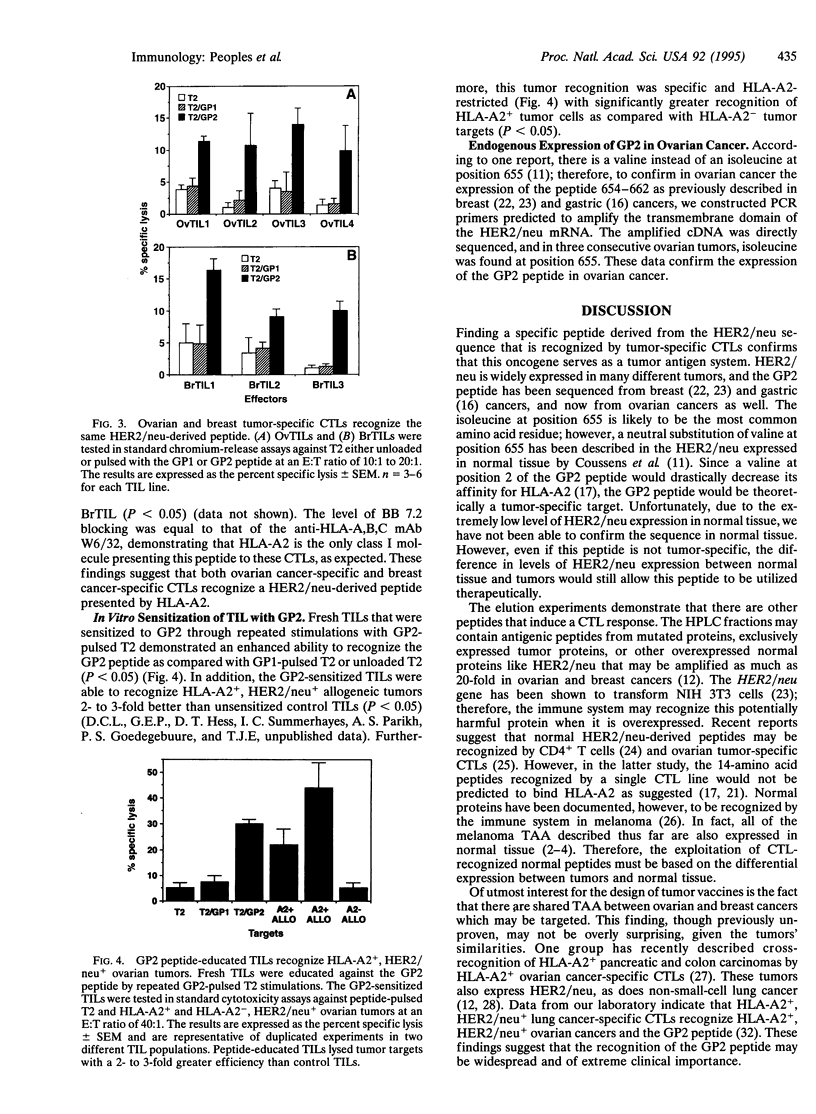
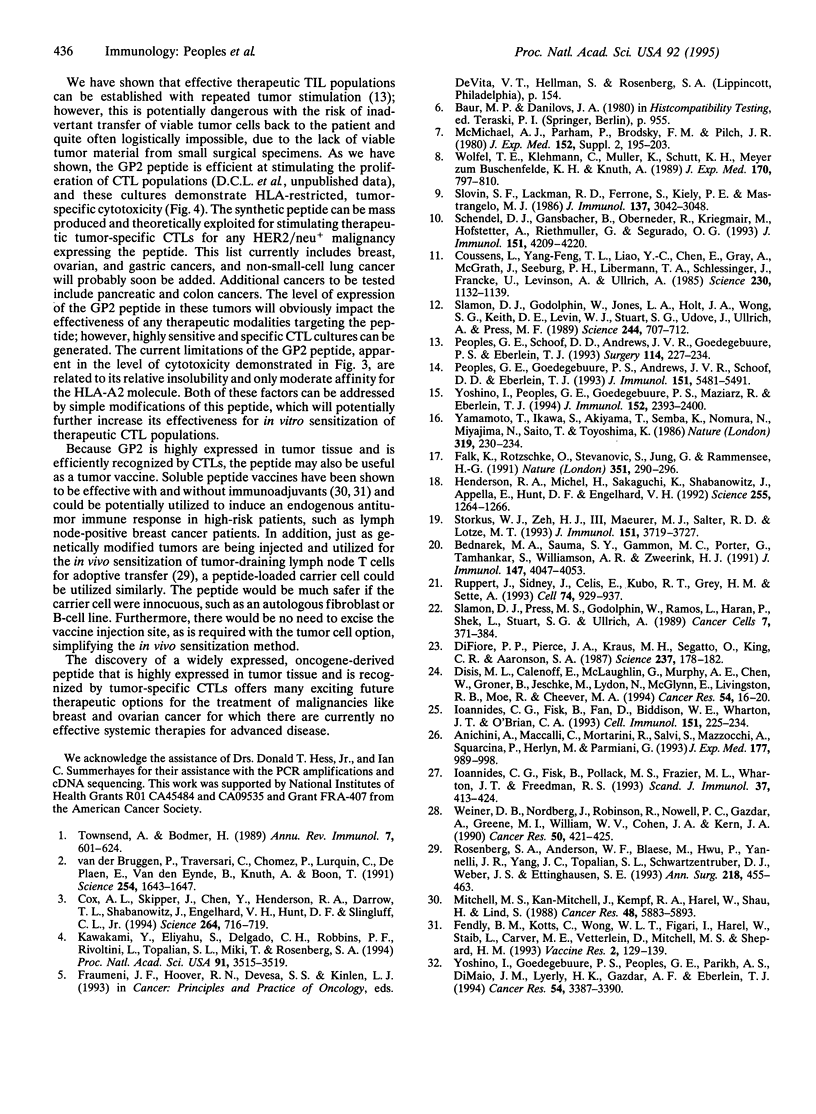
Selected References
These references are in PubMed. This may not be the complete list of references from this article.
- Anichini A., Maccalli C., Mortarini R., Salvi S., Mazzocchi A., Squarcina P., Herlyn M., Parmiani G. Melanoma cells and normal melanocytes share antigens recognized by HLA-A2-restricted cytotoxic T cell clones from melanoma patients. J Exp Med. 1993 Apr 1;177(4):989–998. doi: 10.1084/jem.177.4.989. [DOI] [PMC free article] [PubMed] [Google Scholar]
- Bednarek M. A., Sauma S. Y., Gammon M. C., Porter G., Tamhankar S., Williamson A. R., Zweerink H. J. The minimum peptide epitope from the influenza virus matrix protein. Extra and intracellular loading of HLA-A2. J Immunol. 1991 Dec 15;147(12):4047–4053. [PubMed] [Google Scholar]
- Coussens L., Yang-Feng T. L., Liao Y. C., Chen E., Gray A., McGrath J., Seeburg P. H., Libermann T. A., Schlessinger J., Francke U. Tyrosine kinase receptor with extensive homology to EGF receptor shares chromosomal location with neu oncogene. Science. 1985 Dec 6;230(4730):1132–1139. doi: 10.1126/science.2999974. [DOI] [PubMed] [Google Scholar]
- Cox A. L., Skipper J., Chen Y., Henderson R. A., Darrow T. L., Shabanowitz J., Engelhard V. H., Hunt D. F., Slingluff C. L., Jr Identification of a peptide recognized by five melanoma-specific human cytotoxic T cell lines. Science. 1994 Apr 29;264(5159):716–719. doi: 10.1126/science.7513441. [DOI] [PubMed] [Google Scholar]
- Di Fiore P. P., Pierce J. H., Kraus M. H., Segatto O., King C. R., Aaronson S. A. erbB-2 is a potent oncogene when overexpressed in NIH/3T3 cells. Science. 1987 Jul 10;237(4811):178–182. doi: 10.1126/science.2885917. [DOI] [PubMed] [Google Scholar]
- Disis M. L., Calenoff E., McLaughlin G., Murphy A. E., Chen W., Groner B., Jeschke M., Lydon N., McGlynn E., Livingston R. B. Existent T-cell and antibody immunity to HER-2/neu protein in patients with breast cancer. Cancer Res. 1994 Jan 1;54(1):16–20. [PubMed] [Google Scholar]
- Falk K., Rötzschke O., Stevanović S., Jung G., Rammensee H. G. Allele-specific motifs revealed by sequencing of self-peptides eluted from MHC molecules. Nature. 1991 May 23;351(6324):290–296. doi: 10.1038/351290a0. [DOI] [PubMed] [Google Scholar]
- Henderson R. A., Michel H., Sakaguchi K., Shabanowitz J., Appella E., Hunt D. F., Engelhard V. H. HLA-A2.1-associated peptides from a mutant cell line: a second pathway of antigen presentation. Science. 1992 Mar 6;255(5049):1264–1266. doi: 10.1126/science.1546329. [DOI] [PubMed] [Google Scholar]
- Ioannides C. G., Fisk B., Fan D., Biddison W. E., Wharton J. T., O'Brian C. A. Cytotoxic T cells isolated from ovarian malignant ascites recognize a peptide derived from the HER-2/neu proto-oncogene. Cell Immunol. 1993 Oct 1;151(1):225–234. doi: 10.1006/cimm.1993.1233. [DOI] [PubMed] [Google Scholar]
- Ioannides C. G., Fisk B., Pollack M. S., Frazier M. L., Taylor Wharton J., Freedman R. S. Cytotoxic T-cell clones isolated from ovarian tumour infiltrating lymphocytes recognize common determinants on non-ovarian tumour clones. Scand J Immunol. 1993 Apr;37(4):413–424. doi: 10.1111/j.1365-3083.1993.tb03312.x. [DOI] [PubMed] [Google Scholar]
- Kawakami Y., Eliyahu S., Delgado C. H., Robbins P. F., Rivoltini L., Topalian S. L., Miki T., Rosenberg S. A. Cloning of the gene coding for a shared human melanoma antigen recognized by autologous T cells infiltrating into tumor. Proc Natl Acad Sci U S A. 1994 Apr 26;91(9):3515–3519. doi: 10.1073/pnas.91.9.3515. [DOI] [PMC free article] [PubMed] [Google Scholar]
- Mitchell M. S., Kan-Mitchell J., Kempf R. A., Harel W., Shau H. Y., Lind S. Active specific immunotherapy for melanoma: phase I trial of allogeneic lysates and a novel adjuvant. Cancer Res. 1988 Oct 15;48(20):5883–5893. [PubMed] [Google Scholar]
- Peoples G. E., Goedegebuure P. S., Andrews J. V., Schoof D. D., Eberlein T. J. HLA-A2 presents shared tumor-associated antigens derived from endogenous proteins in ovarian cancer. J Immunol. 1993 Nov 15;151(10):5481–5491. [PubMed] [Google Scholar]
- Peoples G. E., Schoof D. D., Andrews J. V., Goedegebuure P. S., Eberlein T. J. T-cell recognition of ovarian cancer. Surgery. 1993 Aug;114(2):227–234. [PubMed] [Google Scholar]
- Rosenberg S. A., Anderson W. F., Blaese M., Hwu P., Yannelli J. R., Yang J. C., Topalian S. L., Schwartzentruber D. J., Weber J. S., Ettinghausen S. E. The development of gene therapy for the treatment of cancer. Ann Surg. 1993 Oct;218(4):455–464. doi: 10.1097/00000658-199310000-00006. [DOI] [PMC free article] [PubMed] [Google Scholar]
- Ruppert J., Sidney J., Celis E., Kubo R. T., Grey H. M., Sette A. Prominent role of secondary anchor residues in peptide binding to HLA-A2.1 molecules. Cell. 1993 Sep 10;74(5):929–937. doi: 10.1016/0092-8674(93)90472-3. [DOI] [PubMed] [Google Scholar]
- Schendel D. J., Gansbacher B., Oberneder R., Kriegmair M., Hofstetter A., Riethmüller G., Segurado O. G. Tumor-specific lysis of human renal cell carcinomas by tumor-infiltrating lymphocytes. I. HLA-A2-restricted recognition of autologous and allogeneic tumor lines. J Immunol. 1993 Oct 15;151(8):4209–4220. [PubMed] [Google Scholar]
- Slamon D. J., Godolphin W., Jones L. A., Holt J. A., Wong S. G., Keith D. E., Levin W. J., Stuart S. G., Udove J., Ullrich A. Studies of the HER-2/neu proto-oncogene in human breast and ovarian cancer. Science. 1989 May 12;244(4905):707–712. doi: 10.1126/science.2470152. [DOI] [PubMed] [Google Scholar]
- Slovin S. F., Lackman R. D., Ferrone S., Kiely P. E., Mastrangelo M. J. Cellular immune response to human sarcomas: cytotoxic T cell clones reactive with autologous sarcomas. I. Development, phenotype, and specificity. J Immunol. 1986 Nov 1;137(9):3042–3048. [PubMed] [Google Scholar]
- Storkus W. J., Zeh H. J., 3rd, Maeurer M. J., Salter R. D., Lotze M. T. Identification of human melanoma peptides recognized by class I restricted tumor infiltrating T lymphocytes. J Immunol. 1993 Oct 1;151(7):3719–3727. [PubMed] [Google Scholar]
- Townsend A., Bodmer H. Antigen recognition by class I-restricted T lymphocytes. Annu Rev Immunol. 1989;7:601–624. doi: 10.1146/annurev.iy.07.040189.003125. [DOI] [PubMed] [Google Scholar]
- Weiner D. B., Nordberg J., Robinson R., Nowell P. C., Gazdar A., Greene M. I., Williams W. V., Cohen J. A., Kern J. A. Expression of the neu gene-encoded protein (P185neu) in human non-small cell carcinomas of the lung. Cancer Res. 1990 Jan 15;50(2):421–425. [PubMed] [Google Scholar]
- Wölfel T., Klehmann E., Müller C., Schütt K. H., Meyer zum Büschenfelde K. H., Knuth A. Lysis of human melanoma cells by autologous cytolytic T cell clones. Identification of human histocompatibility leukocyte antigen A2 as a restriction element for three different antigens. J Exp Med. 1989 Sep 1;170(3):797–810. doi: 10.1084/jem.170.3.797. [DOI] [PMC free article] [PubMed] [Google Scholar]
- Yamamoto T., Ikawa S., Akiyama T., Semba K., Nomura N., Miyajima N., Saito T., Toyoshima K. Similarity of protein encoded by the human c-erb-B-2 gene to epidermal growth factor receptor. Nature. 1986 Jan 16;319(6050):230–234. doi: 10.1038/319230a0. [DOI] [PubMed] [Google Scholar]
- Yoshino I., Goedegebuure P. S., Peoples G. E., Parikh A. S., DiMaio J. M., Lyerly H. K., Gazdar A. F., Eberlein T. J. HER2/neu-derived peptides are shared antigens among human non-small cell lung cancer and ovarian cancer. Cancer Res. 1994 Jul 1;54(13):3387–3390. [PubMed] [Google Scholar]
- Yoshino I., Peoples G. E., Goedegebuure P. S., Maziarz R., Eberlein T. J. Association of HER2/neu expression with sensitivity to tumor-specific CTL in human ovarian cancer. J Immunol. 1994 Mar 1;152(5):2393–2400. [PubMed] [Google Scholar]
- van der Bruggen P., Traversari C., Chomez P., Lurquin C., De Plaen E., Van den Eynde B., Knuth A., Boon T. A gene encoding an antigen recognized by cytolytic T lymphocytes on a human melanoma. Science. 1991 Dec 13;254(5038):1643–1647. doi: 10.1126/science.1840703. [DOI] [PubMed] [Google Scholar]


